About heating and water supply systems: centralized and
Heating systems, water supply and sewage systems used in the construction of houses and apartments may have a very different configuration. However, by and large, two fundamentally different schemes can be distinguished - autonomous and centralized. Each of them has both its supporters and its opponents, so before starting construction, repair or reconstruction it is very important to weigh all the pros and cons of the chosen solution.
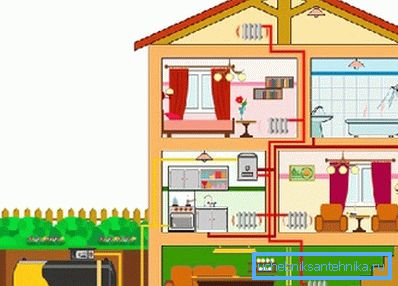
Warm in the house
Heating from the boiler room
Centralized water and heating schemes are common to most apartment buildings. They are convenient, first of all, because heat generation and water transportation take place without the participation of the apartment owner, which greatly facilitates the operation of the entire system.
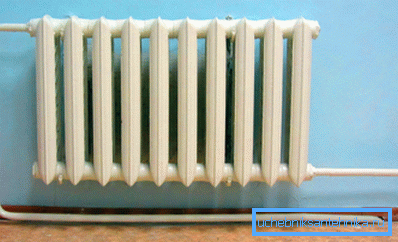
If we talk about centralized heating, then its features are as follows:
- Heat carrier (hot water or steam) is heated immediately for many facilities at special boiler stations.. At the same time, energy-intensive equipment is used, which allows to obtain a large output of thermal energy. True, the heat loss will be very significant.
Note! European water and steam boilers, which recently began to be installed in some boilers, are more economical. But such equipment is expensive, because the complete replacement of outdated boilers is still far.
- The heated water is transported through pipes to homes and other heated objects.. Here lies another disadvantage of the system: if the pipelines are not equipped with insulation, then much of the energy will be lost due to natural cooling.
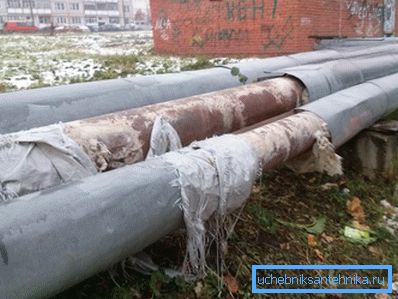
- After entering the house, the coolant is distributed along the contours and moves to the radiators, where the direct heat transfer takes place. We practically can not regulate its intensity (except for valves that reduce the flow of the coolant), so that when nedotop will have to include additional electrical heating.
As you can see, despite the obvious convenience, a centralized room heating system also has disadvantages, the main of which is low energy efficiency. That is why, in order to reduce financial costs, it is often abandoned in favor of apartment heating.
Autonomous circuit
Heating and water supply schemes that provide maximum independence from highways are most conveniently implemented in private homes. However, it is possible to install an individual set of equipment in the apartment, but in this case you will encounter many bureaucratic obstacles.
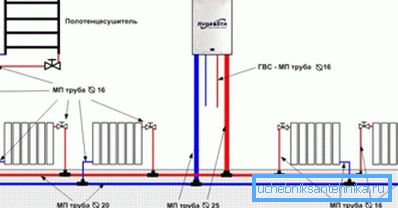
Note! As a rule, the right to disconnect from centralized heating must be proved in court. The likelihood of a positive decision will be higher if the statement was written by all residents of the house or porch. Otherwise, you will either be refused or will be obliged to pay for the transit of heat, which will bring all the savings “to nothing”.
The process of installing an autonomous system is simple:
- To heat the coolant we use the boiler. Electric or gas models of compact size will fit into the apartment, and in a private house you can even install a solid fuel model working on wood, coal or pellets.
- We connect an expansion tank for the heat carrier to the heater.
- The periphery remains the same as in the case of centralized heating: on the walls we place radiators connected to the boiler with pipes made of metal or heat-resistant polymer.
Tip! Part of the pipes can be drowned in the screed for arranging underfloor heating.
- To improve the efficiency of the system, the instruction recommends installing a thermostat. It will register the microclimate parameters in the room, if necessary, turning on and off the boiler in automatic mode.
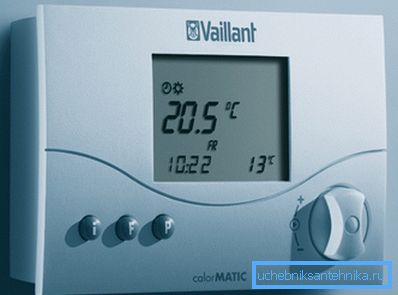
It should be noted that although the price of equipment for autonomous heating will be high, these costs will pay off in just a few years, since you will only pay for the heat that you actually consume.
Water supply
Connection to the highway
The heating and water supply system, which is based on a centralized scheme, is quite convenient in a private house.
So, if we talk about plumbing, then:
- When connecting to a central network does not need to use additional equipment.
- The costs of laying communications will be relatively small.
- Cleaning of heating and water supply systems is carried out in a planned and centralized manner, and sometimes at the expense of the managing organization itself.

At the same time, there is a central water supply and cons:
- So, the availability of water in our country directly depends on the state of the equipment at the pumping station, and we can only influence it indirectly.
- The same applies to the pressure in the network: with a large volume of selection (for example, during mass irrigation) a situation may arise when a thin stream flows from the tap.
- The quality of the incoming water is also different: if you use outdated cleaning equipment, you will have to install additional filters in the house.
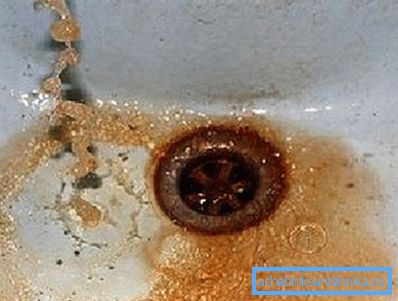
Own water
To compensate for these shortcomings, many owners of private houses with their own hands equip an autonomous water supply system:

- Either a well acts as a source of water (if the groundwater is relatively shallow), or a well, the depth of which can reach 300 meters. Of course, the costs of their arrangement will make up the lion's share of all financial investments, but with proper operation, you can use the source for more than a decade.
- In order not to experience inconvenience when buckets raise water, a submersible pump is mounted in the well. For more comfortable use of the system, automatic pumping stations are used with reserve tanks, which are filled in automatic mode.

- A mandatory part of this water supply scheme is the cleaning system. If high-quality water lies under the plot, then a simple mechanical filter can be dispensed with, but sometimes it is necessary to install special instruments for desalting, disinfecting, removing sulfur, iron, etc.
On the one hand, labor costs in arranging autonomous water supply will be immeasurably greater than when connected to the main line. But on the other - so we will be able to control all the parameters, starting from the volume and ending with the composition of the water used.
Conclusion
Both centralized and autonomous heating systems - water supply - sewage systems have the right to exist.
But if the dignity of the first is the ease of operation, the arrangement of individual equipment complexes not only saves, but also provides a significant increase in comfort. In order to study the technologies described in the article in more detail, we recommend viewing the video posted on the page containing additional information on this topic.